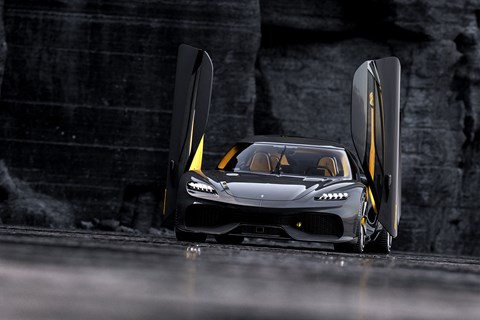► World’s first ‘Mega-GT’, says Koenigsegg
► 1700bhp from 2.0 litres, three e-motors
► Four-wheel everything, 0-62 in 1.9sec
I think my brain has just melted. Koenigsegg’s show star at the Geneva-that-never-was is a four-seater hybrid GT with a mid-mounted engine, 1700bhp and a 0-62mph time of 1.9 seconds.
It’s called the Koenigsegg Gemera. And none of that is even the really mad sh*t.
Errr, where do we start here?
Well, it looks good, right? I think we can all agree on that – even if BMW has set the Geneva 2020 bar particularly low. And being a Koenigsegg, it’s still got those crazy doors that pop out and then rotate upwards around a single axis. Except that in the Gemera’s case they’re absolutely enormous, because they also serve as access to the rear seats as well.

As the crazy Swedes cooly point out, this means there’s no B-pillar, making getting in and out of the back a little more graceful than in most hyper-GTs. Although you’ll still have to deal with those heavily sculpted bucket seats. Pictures make rear legroom look decent, too, but that might be deceptive.
Enough of the practicalities – how does that mid-engine layout work?
Koenigsegg is never a firm to do things the obvious way. So, rather than put the engine in the front, it’s put it in the middle, just behind the passenger cell.
Making the packaging a little easier, it’s not one of the usual screaming V8s, but a new 2.0-litre dry-sump three-cylinder methanol-burning motor with two turbos and a Freevalve system that replaces old-fashioned camshafts with independent control of the intake and exhaust valves while also eliminating the traditional throttle.

Koenigsegg calls it the Tiny Friendly Giant – or TFG – and reckons it’s 15-20% more efficient than a conventional four-cylinder motor, not least because it can modify its combustion cycle to suit the driving conditions. So much so it requires what K-egg calls an artificial intelligence system for control.
There are also no throttle loses, it can deactivate cylinders on demand and runs an unusually high compression ratio for a boosted engine. Each turbo is connected to three exhaust valves, emissions are said to be super clean, and in the Gemera the whole thing breathes through a titanium Akrapovic exhaust system that exits out of the top of the rear decklid.
Presumably it sounds utterly nuts.
More to the ‘Mega-GT’ point, the TFG produces a claimed 600bhp and 442.5lb ft (600Nm).
Which is… a lot.
So how does the 600bhp become 1700bhp in the Gemera?
Easy (ha). In addition to the TFG, the Gemera’s got three electric motors – one for each of the rear wheels and another attached to the crankshaft (although this motor is positioned at the front of the car, so perhaps this is a mis-translation of driveshaft).
The two rear wheel e-motors are each worth 500bhp / 737.5lb ft, while the shocker on the crank delivers another 400bhp / 369lb ft.

At the point where everything lines up, the three electric motors plus the twin-turbo achieve that headline 1700bhp – not mention 2581lb ft of torque.
‘Creating,’ as Koenigsegg wryly suggests ‘quite the undertaking for the Gemera’s massive and grippy Michelin Pilot Sport 4S tyres.’
Presumably all those motors mean there’s potential for some cutting edge dynamic shenanigans?
No kidding. The Gemera has four-wheel torque vectoring and ‘independent’ four-wheel steering, plus an active ride height system.
In order for it to have four-wheel torque vectoring it also has to have four wheel drive, which it achieves by means of an open front differential and a pair of wet clutch packs – an arrangement that appears to be similar to the system the third-generation Ford Focus RS used on the rear.

Goodness only knows how much computer code goes in to making this all work properly.
Phew. Is that all of the crazy here?
Not quite. You probably guessed the Gemera has some pure-EV capability, and indeed, using the same 15kWh 800v battery technology as the Regera it can apparently travel for up to 31 miles without troubling the combustion process.
The electric only output is a mere 1,100bhp. Total range with the petrol engine is quoted at 620 miles between fill ups.

The Gemera also uses the same Koenigsegg Direct Drive (KDD) transmission as the Regera – meaning it has just a single gear from a standstill all the way up to its maximum speed.
By comparison other details such as the rear view cameras that replace the door mirrors, the vast acreages of touchscreen inside the cabin and the way there are air vents incorporated into the front and rear lights are practically pedestrian.

The all-carbon centre-lock wheels are still sexy, though. Plus, you get two wireless phone chargers, and eight cup holders – one hot and one cold for each passenger.
Honestly, I’m not making that up.
So how fast is the Koenigsegg Gemera?
Koenigsegg says 0-62mph takes 1.9sec, and although top speed isn’t quoted the, the transmission is capable of 400km/h – that’s 248mph. Kerbweight is 1850kg.
Safety kit includes AEB, six airbags, three-stage traction control – normal, wet and track – and two fire extinguishers.
Koenigsegg will build 300 Gemeras, and you can register your interest on its website. Which doesn’t yet mention a price.
A-Z of the Geneva motor show on CAR